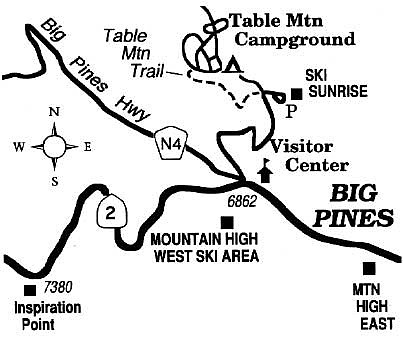Here's something you might be interested in.
Get Involved
 Facebook
Facebook
 X
X
 Instagram
Instagram
 TikTok
TikTok
 Youtube
Youtube
Big Pines Recreation Area, part of Angeles National Forest, perches atop the easternmost extremity of the San Gabriel Mountains, west of Cajon Pass. Blanketed by a heterogeneous mixture of pines, firs, and oaks, and perched high above the Mojave Desert, Big Pines boasts the clean, dry, evergreen-scented air and crystalline blue skies characteristic of the melding of mountain and high-desert environments. During the winter months, Big Pines' three downhill-ski areas draw crowds of snow-starved city-dwellers who would rather not drive an extra 200 miles or more to reach major ski resorts in the Sierra. In summer, several campgrounds in the area (including the big, 115-space Table Mountain Campground), picnic areas, and interpretive trails serve the wants and needs of visitors escaping the lowland heat.
From San Diego, the fastest route to Big Pines is by way of Interstate 15 north, State Route 138 west, and State Route 2 (Angeles Crest Highway) west. The entire trip should take less than three hours, assuming light traffic. Big Pines and nearby Wrightwood share the distinction of lying smack dab on the San Andreas Fault. The crossroads of Big Pines itself (four miles west of Wrightwood) marks the highest surface trace of the entire fault -- 6862 feet.
At the Big Pines crossroads you'll find the Grassy Hollow visitors' center, open weekends, with interpretive exhibits and information available about camping and recreation opportunities in the area. One of the better trails, the one-mile-long Table Mountain Nature Trail, swings down a hillside below the entrance of Table Mountain Campground and later climbs back up to the campground's edge. You'll be introduced to Jeffrey pines, canyon live oaks, black oaks, and other plants thriving at 7000 feet elevation. Numbered posts along the trail correspond to the entries on a self-guiding leaflet available at the Grassy Hollow visitors' center.
As you're traversing the south-facing slope traveled by the trail, you'll spot 9399-foot Mt. Baden-Powell rising impressively in the west and nearby Blue Ridge, with ski-run scars on it, in the southeast. Blue Ridge was logged several decades ago, accounting for the even-aged appearance of the trees on its slopes. Watch out for false paths that take off from some of the switchback corners of the trail; it's easy to lose the main trail. At trail's end, make a right on the paved campground road and walk back to the start of the trail.
Note that here, as in all national forests within Southern California, you'll need to post a National Forest Adventure Pass ($5 per day, $30 per year) on your car for the privilege of parking. For more information, call 626-821-6737 or 626-574-5200.


Big Pines Recreation Area, part of Angeles National Forest, perches atop the easternmost extremity of the San Gabriel Mountains, west of Cajon Pass. Blanketed by a heterogeneous mixture of pines, firs, and oaks, and perched high above the Mojave Desert, Big Pines boasts the clean, dry, evergreen-scented air and crystalline blue skies characteristic of the melding of mountain and high-desert environments. During the winter months, Big Pines' three downhill-ski areas draw crowds of snow-starved city-dwellers who would rather not drive an extra 200 miles or more to reach major ski resorts in the Sierra. In summer, several campgrounds in the area (including the big, 115-space Table Mountain Campground), picnic areas, and interpretive trails serve the wants and needs of visitors escaping the lowland heat.
From San Diego, the fastest route to Big Pines is by way of Interstate 15 north, State Route 138 west, and State Route 2 (Angeles Crest Highway) west. The entire trip should take less than three hours, assuming light traffic. Big Pines and nearby Wrightwood share the distinction of lying smack dab on the San Andreas Fault. The crossroads of Big Pines itself (four miles west of Wrightwood) marks the highest surface trace of the entire fault -- 6862 feet.
At the Big Pines crossroads you'll find the Grassy Hollow visitors' center, open weekends, with interpretive exhibits and information available about camping and recreation opportunities in the area. One of the better trails, the one-mile-long Table Mountain Nature Trail, swings down a hillside below the entrance of Table Mountain Campground and later climbs back up to the campground's edge. You'll be introduced to Jeffrey pines, canyon live oaks, black oaks, and other plants thriving at 7000 feet elevation. Numbered posts along the trail correspond to the entries on a self-guiding leaflet available at the Grassy Hollow visitors' center.
As you're traversing the south-facing slope traveled by the trail, you'll spot 9399-foot Mt. Baden-Powell rising impressively in the west and nearby Blue Ridge, with ski-run scars on it, in the southeast. Blue Ridge was logged several decades ago, accounting for the even-aged appearance of the trees on its slopes. Watch out for false paths that take off from some of the switchback corners of the trail; it's easy to lose the main trail. At trail's end, make a right on the paved campground road and walk back to the start of the trail.
Note that here, as in all national forests within Southern California, you'll need to post a National Forest Adventure Pass ($5 per day, $30 per year) on your car for the privilege of parking. For more information, call 626-821-6737 or 626-574-5200.
